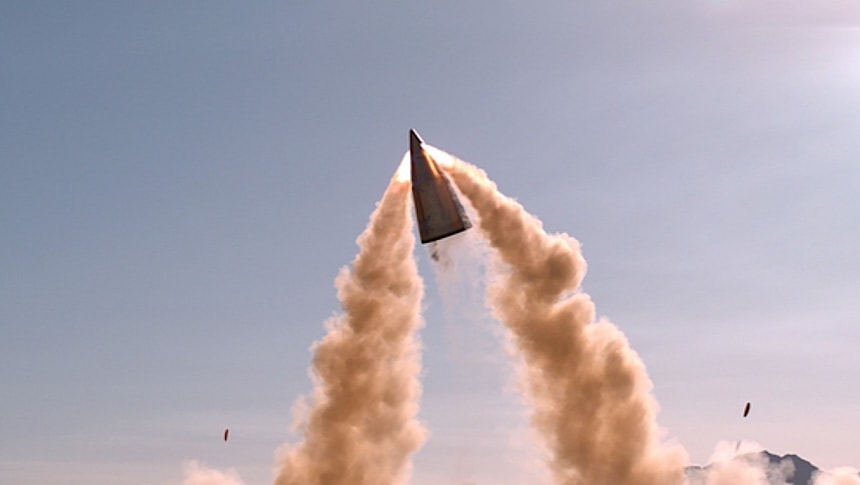As per the official numbers, the U.S. has exactly 400 LGM-30G Minuteman III intercontinental ballistic missiles (ICBM) at its disposal, all of them capable of carrying nuclear warheads and all under the control of the Air Force Global Strike Command. It's an impressive and massive deterrence arsenal, but it is sadly growing old and it will soon need to be replaced.
The Minuteman was developed by Boeing in the late 1950s, at the height of the Cold War. At its time, it was a revolutionary concept, as it gave America the chance to strike at its enemies from hardened silos spread across the country.
The missiles have a range of 6,000 miles (9,600 km) and fly at impossible-to-intercept speeds of 15,000 mph (24,000 kph) thanks to three solid-propellant rocket motors in a three-stage setup.
That sounds impressive and all, but adapting the Minuteman to the requirements of today and maintaining the current inventory (no new ones have been made since 1978) is becoming increasingly difficult and costly.
That's why in 2020 the U.S. Air Force began looking for a replacement for the ICBMs under a program called Ground Based Strategic Deterrent (GBSD). And that replacement, we've known for a while now, is the so-called LGM-35A Sentinel.
The missile follows the same naming nomenclature as the Minuteman, with "L” being the designation for silo-launched, "G” representing ground attack, and "M” standing it for guided missile. 35A is the representation of the missile's series and version.
We've had a chance to discuss the Sentinel before, as from time to time the main contractor for the project, Northrop Grumman, lets slip minor details about the project. It did the same this week when it announced it had "successfully completed tests of several crucial elements" of the ICBM.
The announcement comes on the heels of the first test fire of the missile's second stage (it too will have three stages, like the Minuteman). That happened at the beginning of the year.
The new tests announced this week were conducted at the Strategic Missile Test and Production Complex in Promontory, Utah, and targeted the forward and aft sections of the Sentinel.
More to the point, Northrop Grumman's people performed tests on the shroud fly-off and missile stack, key steps in ensuring a successful deployment of the weapon.
As per the company, the tests, whose exact specifics are of course kept under wraps, "proved our modeling predictions are solid" and “demonstrated inflight missile performance."
It's not yet clear when the new ICBM will be ready to replace the existing fleet, but we do know America's military is planning to use it at least until 2075.
Sentinels will be built to be modular, as to allow for the inclusion of new technologies as soon as they mature. Compared to the Minuteman, they are also to be easier and cheaper to maintain and operate.
The missiles have a range of 6,000 miles (9,600 km) and fly at impossible-to-intercept speeds of 15,000 mph (24,000 kph) thanks to three solid-propellant rocket motors in a three-stage setup.
That sounds impressive and all, but adapting the Minuteman to the requirements of today and maintaining the current inventory (no new ones have been made since 1978) is becoming increasingly difficult and costly.
That's why in 2020 the U.S. Air Force began looking for a replacement for the ICBMs under a program called Ground Based Strategic Deterrent (GBSD). And that replacement, we've known for a while now, is the so-called LGM-35A Sentinel.
The missile follows the same naming nomenclature as the Minuteman, with "L” being the designation for silo-launched, "G” representing ground attack, and "M” standing it for guided missile. 35A is the representation of the missile's series and version.
We've had a chance to discuss the Sentinel before, as from time to time the main contractor for the project, Northrop Grumman, lets slip minor details about the project. It did the same this week when it announced it had "successfully completed tests of several crucial elements" of the ICBM.
The announcement comes on the heels of the first test fire of the missile's second stage (it too will have three stages, like the Minuteman). That happened at the beginning of the year.
The new tests announced this week were conducted at the Strategic Missile Test and Production Complex in Promontory, Utah, and targeted the forward and aft sections of the Sentinel.
More to the point, Northrop Grumman's people performed tests on the shroud fly-off and missile stack, key steps in ensuring a successful deployment of the weapon.
As per the company, the tests, whose exact specifics are of course kept under wraps, "proved our modeling predictions are solid" and “demonstrated inflight missile performance."
It's not yet clear when the new ICBM will be ready to replace the existing fleet, but we do know America's military is planning to use it at least until 2075.
Sentinels will be built to be modular, as to allow for the inclusion of new technologies as soon as they mature. Compared to the Minuteman, they are also to be easier and cheaper to maintain and operate.






